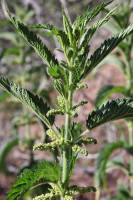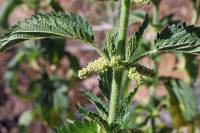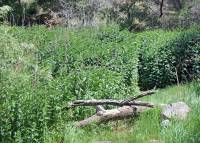Stems softly pubescent, also with stinging hairs. Leaf blades abaxially sparsely to densely tomentose to moderately strigose, soft to touch, with stinging hairs, adaxially without or rarely with a few stinging hairs. Flowers unisexual, staminate and pistillate mostly on same plants. 2 n = 26.
Flowering late spring-summer. Alluvial woods, margins of deciduous or mixed woodlands, fencerows, waste places; 0-3100 m; Ariz., Calif., Colo., Idaho, Mont., Nev., N.Mex., Oreg., Utah, Wash., Wyo.; Mexico.
Urtica dioica subsp. holosericea is highly variable in leaf shape and degree of pubescence. The least pubescent plants appear to grade into U . dioica subsp. gracilis , and it is sometimes difficult to separate the two.
The name U . serra Blume has been misapplied to this taxon.
LEAVES: Lower surface of leaves sparingly to densely tomentose and moderately strigose, soft to the touch, with stinging hairs. 2n = 26.
NOTES: See also parent taxon. Alluvial woods, margins of deciduous or mixed woodlands, fencerows, waste places; n Apache, n Coconino cos.; 2150-3050 m (7000‑10000 ft); late spring‑summer; CA, w CO, ID, sw MT, OR, NM (Catron co.), NV, UT, WA, sw WY; Mex. Highly variable in leaf shape and degree of hairiness. The least hairy plants appear to grade into subsp. gracilis and it is sometimes difficult to separate the two.
REFERENCES: Boufford, David E. 1992. Urticaceae. Ariz.-Nev. Acad. Sci. 26(1)2.






